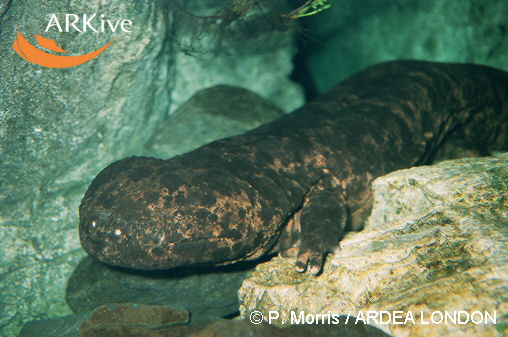
Andrias japonicus (=davidianus j.)
Andrias japonicus (=davidianus j.) NatureServe Explorer Species Reports — NatureServe Explorer is a source for authoritative conservation information on more than 50,000 plants, animals and ecological communtities of the U.S and Canada. NatureServe Explorer provides in-depth information on rare and endangered species, but includes common plants and animals too. NatureServe Explorer is a product of NatureServe in collaboration with the Natural Heritage Network.
ITIS Reports — ITIS (the Integrated Taxonomic Information System) is a source for authoritative taxonomic information on plants, animals, fungi, and microbes of North America and the world.
FWS Digital Media Library — The U.S. Fish and Wildlife Service’s National Digital Library is a searchable collection of selected images, historical artifacts, audio clips, publications, and video.
The Japanese giant salamander (Andrias japonicus) is a species of salamander in the family Cryptobranchidae. The species is endemic to Japan, where it is known as Ōsanshōuo literally meaning “giant pepper fish”. With a length of up to 5 feet (1.5 m), it is the third-largest salamander in the world, only being surpassed by the very similar and closely related Chinese giant salamander (A. davidianus) and South China giant salamander (A. sligoi). There are currently only five known members of the family Cryptobranchidae: the Japanese, Chinese, and South China giant salamanders, an undescribed Andrias species from eastern China, and the hellbender (Cryptobranchus alleganiensis).
Japanese giant salamanders are widespread across rivers in southwestern Japan. The species frequently hybridizes with Chinese giant salamanders, which were introduced to the area.The Japanese giant salamander can be distinguished from the Chinese giant salamander by the arrangement of tubercles on the head and throat. The tubercles are larger and more numerous compared to the mostly single and irregularly scattered tubercles of the Chinese giant salamander. The snout is also more rounded, and the tail is slightly shorter
| Status | Date Listed | Lead Region | Where Listed |
|---|---|---|---|
| Endangered | 06/14/1976 | Foreign (Headquarters) | Wherever found |
- Countries in which the the Japanese Giant salamander, Wherever found is known to occur: Japan
| 06/14/1976 | 41 FR 24062 24067 | Endangered Status for 159 Taxa of Animals; 41 FR 24062 24067 |
| 09/26/1975 | 40 FR 44392 44333 | CITES: Proposed Endangered Status for 216 Species on Convention Appendix I; 40 FR 44392 44333 |












